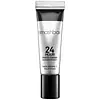What's inside
What's inside
 Key Ingredients
Key Ingredients

 Benefits
Benefits

 Concerns
Concerns

 Ingredients Side-by-side
Ingredients Side-by-side

Dimethicone
EmollientIsododecane
EmollientTalc
AbrasiveDimethicone Silylate
Trihydroxystearin
Skin ConditioningDisteardimonium Hectorite
StabilisingKaolin
AbrasiveHydrogenated Polyisobutene
EmollientPolyethylene
AbrasiveVp/Eicosene Copolymer
Trioctyldodecyl Citrate
EmollientTocopheryl Acetate
AntioxidantLecithin
EmollientTriethylhexanoin
MaskingBisabolol
MaskingSilica
AbrasiveAlumina
AbrasiveEthylene/Methacrylate Copolymer
Propylene Carbonate
SolventSorbitan Sesquioleate
EmulsifyingCaprylyl Glycol
EmollientStearic Acid
CleansingGlycyrrhetinic Acid
Skin ConditioningPEG-40 Stearate
EmulsifyingIsopropyl Titanium Triisostearate
EmollientPentaerythrityl Tetra-Di-T-Butyl Hydroxyhydrocinnamate
AntioxidantMica
Cosmetic ColorantCI 77891
Cosmetic ColorantIron Oxides
CI 77163
Cosmetic ColorantDimethicone, Isododecane, Talc, Dimethicone Silylate, Trihydroxystearin, Disteardimonium Hectorite, Kaolin, Hydrogenated Polyisobutene, Polyethylene, Vp/Eicosene Copolymer, Trioctyldodecyl Citrate, Tocopheryl Acetate, Lecithin, Triethylhexanoin, Bisabolol, Silica, Alumina, Ethylene/Methacrylate Copolymer, Propylene Carbonate, Sorbitan Sesquioleate, Caprylyl Glycol, Stearic Acid, Glycyrrhetinic Acid, PEG-40 Stearate, Isopropyl Titanium Triisostearate, Pentaerythrityl Tetra-Di-T-Butyl Hydroxyhydrocinnamate, Mica, CI 77891, Iron Oxides, CI 77163
Isododecane
EmollientTrimethylsiloxysilicate
EmollientKaolin
AbrasiveSilica
AbrasiveDimethicone
EmollientPolypropylsilsesquioxane
Jojoba Esters
EmollientDisteardimonium Hectorite
StabilisingDiethylhexyl Syringylidenemalonate
Skin ProtectingPhenoxyethanol
PreservativeSilica Dimethyl Silylate
EmollientPropylene Carbonate
SolventCaprylyl Glycol
EmollientCaprylic/Capric Triglyceride
MaskingTocopheryl Acetate
AntioxidantMangifera Indica Seed Butter
Skin ConditioningButyrospermum Parkii Butter
Skin ConditioningTocopherol
AntioxidantCI 77891
Cosmetic ColorantCI 77492
Cosmetic ColorantCI 16035
Cosmetic ColorantCI 77491
Cosmetic ColorantIsododecane, Trimethylsiloxysilicate, Kaolin, Silica, Dimethicone, Polypropylsilsesquioxane, Jojoba Esters, Disteardimonium Hectorite, Diethylhexyl Syringylidenemalonate, Phenoxyethanol, Silica Dimethyl Silylate, Propylene Carbonate, Caprylyl Glycol, Caprylic/Capric Triglyceride, Tocopheryl Acetate, Mangifera Indica Seed Butter, Butyrospermum Parkii Butter, Tocopherol, CI 77891, CI 77492, CI 16035, CI 77491
Ingredients Explained
These ingredients are found in both products.
Ingredients higher up in an ingredient list are typically present in a larger amount.
Caprylyl Glycol is a humectant and emollient, meaning it attracts and preserves moisture.
It is a common ingredient in many products, especially those designed to hydrate skin. The primary benefits are retaining moisture, skin softening, and promoting a healthy skin barrier.
Though Caprylyl Glycol is an alcohol derived from fatty acids, it is not the kind that can dry out skin.
This ingredient is also used as a preservative to extend the life of products. It has slight antimicrobial properties.
Learn more about Caprylyl GlycolCi 77891 is a white pigment from Titanium dioxide. It is naturally found in minerals such as rutile and ilmenite.
It's main function is to add a white color to cosmetics. It can also be mixed with other colors to create different shades.
Ci 77891 is commonly found in sunscreens due to its ability to block UV rays.
Learn more about CI 77891Dimethicone is a type of synthetic silicone created from natural materials such as quartz.
What it does:
Dimethicone comes in different viscosities:
Depending on the viscosity, dimethicone has different properties.
Ingredients lists don't always show which type is used, so we recommend reaching out to the brand if you have questions about the viscosity.
This ingredient is unlikely to cause irritation because it does not get absorbed into skin. However, people with silicone allergies should be careful about using this ingredient.
Note: Dimethicone may contribute to pilling. This is because it is not oil or water soluble, so pilling may occur when layered with products. When mixed with heavy oils in a formula, the outcome is also quite greasy.
Learn more about DimethiconeDisteardimonium Hectorite comes from the clay mineral named hectorite. It is used to add thickness to a product.
It can also help stabilize a product by helping to disperse other ingredients.
Hectorite is a rare, white clay mineral.
Learn more about Disteardimonium HectoriteIsododecane is a fragrance, emollient, and solvent.
As an emollient, it helps your skin stay soft and hydrated. Emollients help trap moisture into your skin.
Isododecane's role as a solvent makes it a great texture enhancer. It spreads smoothly on skin and does not leave a sticky feeling behind. Isododecane also helps prevent color transfer in makeup products.
Isododecane is not absorbed into skin.
Learn more about IsododecaneKaolin is a clay. It is used for oil control and to help minimize pores. Like other clays, kaolin has the ability to absorb excess sebum or oil. This can help clean out pores and mattify the skin.
Some types of kaolin may have exfoliating properties. When water is added to kaolin, it becomes a paste with small abrasive particles.
Most kaolin is a white color, but may be pink/orange/red depending on where it comes from.
The name 'kaolin' comes from a Chinese village named 'Gaoling'. Kaolin clay comes from rocks rich in kaolinite. Kaolinite, the mineral, has a silicate layered structure. Kaolinite is formed from chemical weathering of aluminum siilicate minerals.
Besides skincare, kaolin is commonly used to make glossy paper, in ceramics, toothpaste, and as medicine to soothe stomach issues.
Learn more about KaolinThis ingredient is a solvent. It helps dissolve active ingredients and alter the texture of products.
Propylene Carbonate is commonly used in makeup and with clay, such as montmorillonite or bentonite.
Studies show this ingredient to be safe for cosmetics. When it is undiluted, it can cause skin irritation. (It is always diluted in skincare and makeup). This ingredient is water-soluble.
Propylene Carbonate is created from propylene glycol and carbonic acid.
Learn more about Propylene CarbonateSilica, also known as silicon dioxide, is a naturally occurring mineral. It is used as a fine, spherical, and porous powder in cosmetics.
Though it has exfoliant properties, the function of silica varies depending on the product.
The unique structure of silica enhances the spreadability and adds smoothness, making it a great texture enhancer.
It is also used as an active carrier, emulsifier, and mattifier due to its ability to absorb excess oil.
In some products, tiny microneedles called spicules are made from silica or hydrolyzed sponge. When you rub them in, they lightly polish away dead skin layers and enhance the penetration of active ingredients.
Learn more about SilicaTocopheryl Acetate is AKA Vitamin E. It is an antioxidant and protects your skin from free radicals. Free radicals damage the skin by breaking down collagen.
One study found using Tocopheryl Acetate with Vitamin C decreased the number of sunburned cells.
Tocopheryl Acetate is commonly found in both skincare and dietary supplements.
Learn more about Tocopheryl Acetate